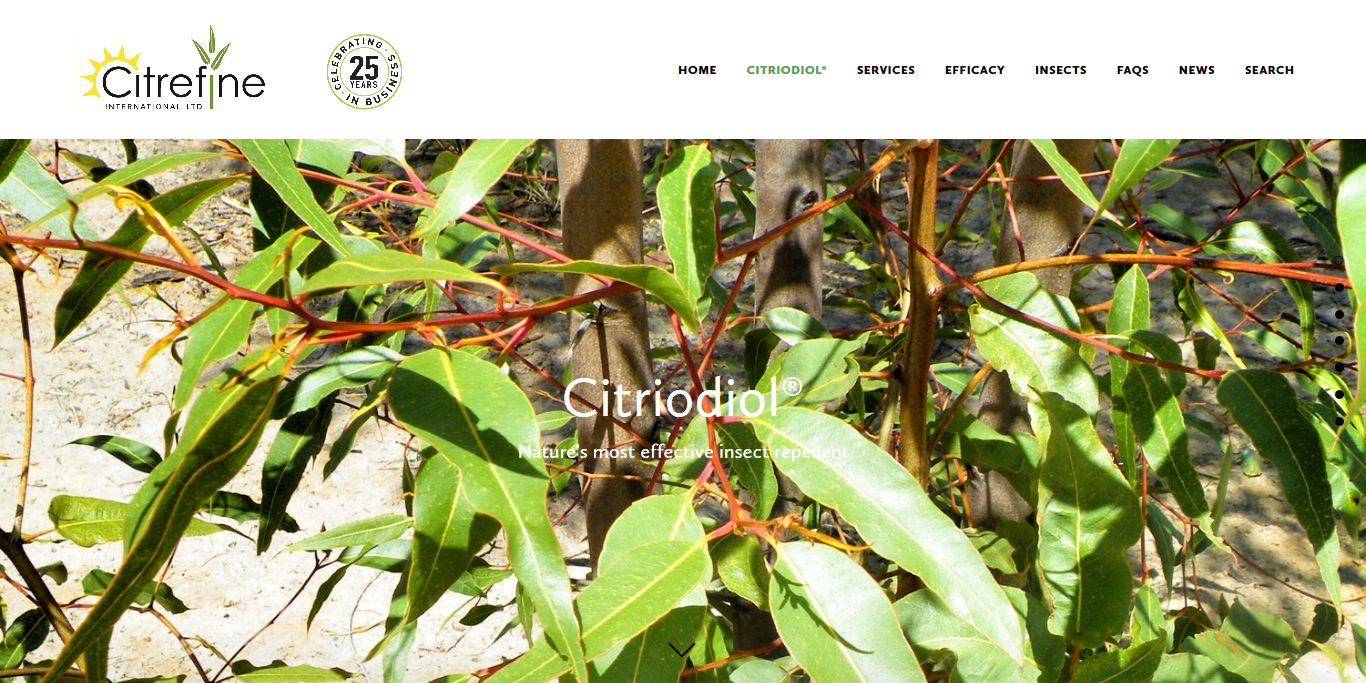Citriodiol® OLE Oil of Lemon Eucalyptus by Citrefine Repels Deer Ticks EPA Approved
Deer ticks repelled by Citrefine Citriodiol® OLE Oil of Lemon Eucalyptus for almost 5 hours, study conducted for EPA submission finds. Use of Citriodiol® OLE insect repellent on children of all ages has been approved EPA.

Oil of Lemon Eucalyptus (OLE), sold under the tradename Citriodiol® OLE by Citrefine International Limited (Citrefine), repels deer ticks for almost 5 hours, study conducted for U.S. Environmental Protection Agency (EPA) submission shows. Results from a new 3-species tick study show Citriodiol® OLE insect repellent provides 100% protection against deer ticks for an average of 290 minutes (almost 5 hours). The study involved 25 human subjects. When tested against the brown dog tick and lone star tick, Citriodiol® OLE provided more than 8 and 10 hours of complete protection respectively. The 30% concentrated spray formula, approved by the EPA, can be used on children of all ages.
Notable info about Citriodiol® OLE can be viewed by visiting: https://www.citrefine.com/citriodiol
As the temperature rises this spring, so does the appeal of going outside to connect with nature. Unfortunately, this also comes with an increased prevalence of deer ticks.
Deer ticks are tiny hard-shelled arachnids that hatch in the spring and fall, feeding on humans, dogs, deer and other mammals. They can transmit Lyme disease (borreliosis) which has symptoms ranging from a bulls-eye shaped rash, headache and fatigue to facial palsy, arthritis, and even inflammation of the brain and spinal cord. Young deer ticks (nymphs) are the size of a pencil tip and are exceptionally difficult to see. The Centers for Disease Control and Prevention (CDC) recommends wearing suitable clothing, such as long pants and socks, and a proven tick repellent when traveling into grassy or forested areas.
"CDC has evaluated information published in peer-reviewed scientific literature and data available from EPA to identify several types of EPA-registered products that provide repellent activity sufficient to help people reduce the bites of disease-carrying insects.", stated John-Paul Mutebi and John E. Gimnig in CDC Yellow Book, Chapter 3 (11), Mosquitoes, Ticks & Other Arthropods. "Products containing the following active ingredients typically provide reasonably long-lasting protection: Oil of lemon eucalyptus (OLE) or PMD (chemical name: para-menthane-3,8-diol), the synthesized version of OLE."
OLE has long been on CDC’s list of active ingredients that work to repel ticks. In 2019, the independent U.K. laboratory ARCTEC carried out a 4-month trial, sponsored by the active ingredient manufacturer Citrefine, to test how long the popular 30% OLE formula would keep deer ticks and two other tick species at bay.
Trial DESIGN: 25 volunteers each exposed a forearm treated with the 30% OLE formula to three different species of ticks [I. scapularis (deer tick), A. americanum (lone star tick) and R. sanguineus (brown dog tick)]. After first placing the tick on the volunteer’s untreated arm to establish it wanted to quest for a blood meal, it was then placed on the volunteer’s other arm treated with the 30% OLE formula. The tick was observed to see if it followed its instinct to move up the person’s arm and feed, or if it dropped off the volunteer’s arm in reaction to the repellent. A new, questing tick was placed on the volunteer’s arm every 15 minutes for 10 hours or until repellency failed. 25 volunteers were tested in total for each species of tick (75 replicates in all). An average complete protection time for all volunteers was calculated.
Trial RESULTS: 30% OLE was shown to provide an average complete protection time against deer ticks of nearly 5 hours (290 minutes). It protected against brown dog ticks for more than 8 hours (532 minutes) and its repellency against the lone star tick was so strong that it exceeded the 10-hour duration of the study.
On December 11, 2019, following its review of the expanded OLE safety dataset, the EPA amended labeling and stated that use of the 30% OLE spray on children of all ages was acceptable.
For more information on EPA Reg. No. 84878-2, visit: https://iaspub.epa.gov/apex/pesticides/f?p=PPLS:8:::NO::P8_PUID:491155
Families can now safely apply Citriodiol® OLE insect repellent to themselves and their youngest family members as they enjoy the great outdoors.
About Citrefine
Citrefine is a family-run British company founded in Leeds, England over 20 years ago. One of Citrefine’s founders, Dr. Paul Clarke, a specialist in tropical medicine, recognized the need for an effective and naturally sourced option to protect against the increasing threat of vector borne disease. Clarke’s primary concern was finding a low-toxicity alternative to DEET, with efficacy rigorous enough to protect against Malaria. Through a multitude of clinical laboratory tests and field trials, it was proven that Citriodiol® OLE readily met this need, and it is now used in well-known insect repellents the world over. Leading authorities worldwide now recognize Citriodiol® OLE’s first-rate efficacy making it the only plant-based repellent with this level of accreditation.
Alongside its UK headquarters, Citrefine established an office in the USA to support its expanding customer base, and now exports its products to over 30 countries globally. It offers a tailored approach to its customers encompassing regulatory, technical, commercial and operational expertise. The in-house regulatory team and scientific laboratory can offer help and support throughout the process of bringing an insect repellent to market.
An experienced, pro-active team dedicated to Citriodiol® OLE can support projects from the R&D phase through to product registrations, launch and beyond.
For more information on Citrefine, visit: https://www.citrefine.com
Connect with Citrefine
Website: https://www.citrefine.com/contact

